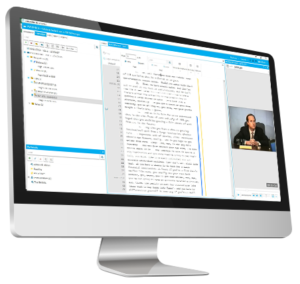
*Editor’s Note: Today’s IPRO blog was written by Joshua Gilliland, a California attorney who focuses his practice on eDiscovery. Josh is the co-creator of The Legal Geeks, which has made the ABA Journal Top Blawg 100 Blawg from 2013 to 2016, the Web 100 from 2017 to 2018, and was nominated for Best Podcast for the 2015 Geekie Awards. Josh has presented at legal conferences and comic book conventions across the United States. He also ties a mean bow tie.
Trial advocacy is a mix of law and theater, requiring a lawyer to know both the law and their audience. Attorneys must effectively argue their client’s case using the evidence and the jury instructions to show their client is right (or has been wronged), and it is up to the jury to put things right.
The opening statement is an opportunity to set the stage for what the trial is about, and the closing argument is the chance to tie all the issues together with a bow. One highly effective strategy for both is using video depositions, but they must meet the requirements in Federal or state court.
Strategic Reasons to Use Video Deposition Clips
Back in 2002, David Narkiewicz described the value of using video depositions in trial as follows:
Without a doubt, trial presentation software is most powerful when used to show a clip of a video deposition while simultaneously showing the transcript for the jury to watch and read. Instead of just showing a video clip, highlighting a particular comment by the witness with a color, such as yellow, can make the use of that clip extremely powerful. You can retrieve this clip by just typing in the page and lines of the transcript, and the video and transcript are played instantly on the screen.
Jurors today have lived with smartphones that allow them to watch videos in the palm of their hand, and many of these jurors are in Generation X or Millennials and want to hear the bottom line and not a presentation that manipulates their emotions.
This requires thinking about how to use short video deposition that conveys the key message, such as “day-in-the-life” videos, or using a specific passage of testimony that sums up a case are effective ways to maximize trial presentation technology to simply state complex information for the jury to understand.
Deposition testimony allows jurors to get an immediate look at a party (or party representative) in a lawsuit. However, just because you can show a line of deposition questions and answers, does not mean you should. The facts of the case can dictate the trial strategy.
As trial presentation expert Ted Brooks of Litigation-Tech has explained, video depositions of deceased parties were used in an asbestos reinsurance case from early in his career. Without the video depositions, the only way the jury would have “heard” the deceased’s testimony was to hear someone read it into the record.
The fundamental strategic reason for using a video deposition clip in an opening statement or closing argument boils down to effectively communicating the key facts of a lawsuit.
How to Prepare Video Deposition Clips
The first step in preparing video deposition clips in TrialDirector 360 is to have a synchronized video deposition. A video deposition can be synched in TimeCoder Pro, but it is highly likely a court reporter firm will provide a synced Digital Video Transcript (DVT file) that can be loaded into TrialDirector 6 or Trialdirector 360.
Video deposition clips can be created by selecting the relevant page and line designations within the transcript. Attorney colloquy and objections in the deposition should be edited out so the clip is only of the question and answer. It is often required that the questions before and after the relevant examination designation need to be included to give context to the answer. As every trial is unique, what needs to be presented can vary.
The main point of having a video excerpt in a closing argument or opening statement is for impact. This could be because a person is deceased, there is an admission of extreme importance, or the deponent gave inconsistent testimony at trial. There are numerous reasons to want to use a video deposition clip, but the key issue is presenting some testimony the jury will not forget when they begin deliberations.
Notes on Depositions from the Federal Rules of Civil Procedure
Federal Rule of Civil Procedure Rule 32 allows a party to use a deposition against an adverse party if the party had was present or represented at the deposition; had notice of the deposition; would be admissible under the Federal Rules of Evidence; and meets one of the Rule 32(a) requirements. Fed Rules Civ Proc R 32(a)(1)(A), (B), and (C).
Federal Courts have allowed video deposition excerpts in opening statements. In one case where a party brought a motion in limine to exclude the use of a video deposition, the Court allowed the video deposition because Rule 32(a)(2) states a deposition can be used for “any purpose” and the opposing party’s conduct was factually relevant and could be alluded to in opening statement. Northfield Ins. Co. v. Royal Surplus Lines Ins. Co. (C.D. Cal. July 7, 2003).
In another case, the proffering party was limited to use video deposition testimony under Federal Rules of Evidence 403 that prohibit cumulative evidence, because the deponent was going to testify at trial. Beem v. Providence Health & Servs. (E.D. Wash. Apr. 19, 2012).
In a complex technology case, the Court granted a motion in limine excluding a video deposition clip from an opening statement, explaining, “…if unrestricted, a video deposition can be shown once in opening, again during trial (at least once), and in closing in the exact same form. Repeatedly showing the same few deposition segments seems to exalt the relevance of those videotaped shreds of evidence over live testimony.” Hynix Semiconductor Inc. v. Rambus Inc. (N.D. Cal. Jan. 21, 2008), citing Federal Judicial Center, Effective Use of Courtroom Technology: A Judge’s Guide to Pretrial and Trial, 156 (2001).
Notice Requirements Regarding Video Depositions
The use of a video deposition in trial is subject to notice requirements under Federal and state Rules of Civil Procedure. In Federal Court, a party must provide a transcript of any deposition testimony the party offers. Fed Rules Civ Proc R 32(c). In California, there must be a notice in writing of the intent to offer video depositions into evidence, which allow for objections and video editing. Cal Code Civ Proc § 2025.340(m). It is pivotal to know the local rules for submitting evidence lists and any standing orders for using video depositions in trial.
Sources:
[1] FEATURE: GENERATION X AND Y’S INFLUENCE IN THE JURY BOX, 50 Orange County Lawyer 42, 44.
[2] THE RANDOLPH W. THROWER SYMPOSIUM: CHANGING LITIGATION WITH SCIENCE AND TECHNOLOGY: VIDEO DEPOSITIONS, TRANSCRIPTS AND TRIALS, 43 Emory L.J. 1071, 1075-1076
[3] FEATURE: UNDERSTANDING AND USING COURTROOM TECHNOLOGY IN THE NEW HARRIS COUNTY CIVIL COURTHOUSE, 44 Houston Lawyer 30, 31
[4] DEPARTMENT: LEGAL TECH: TECHNOLOGY IN THE COURTROOM: TRIAL PRESENTATION SOFTWARE, 24 Pennsylvania Lawyer 49, 49


